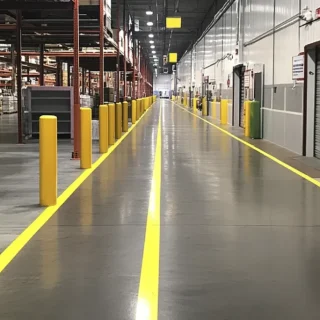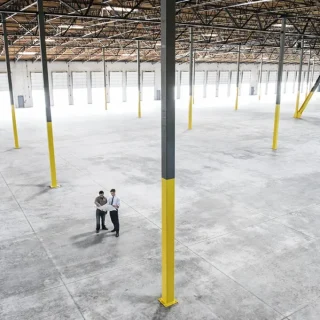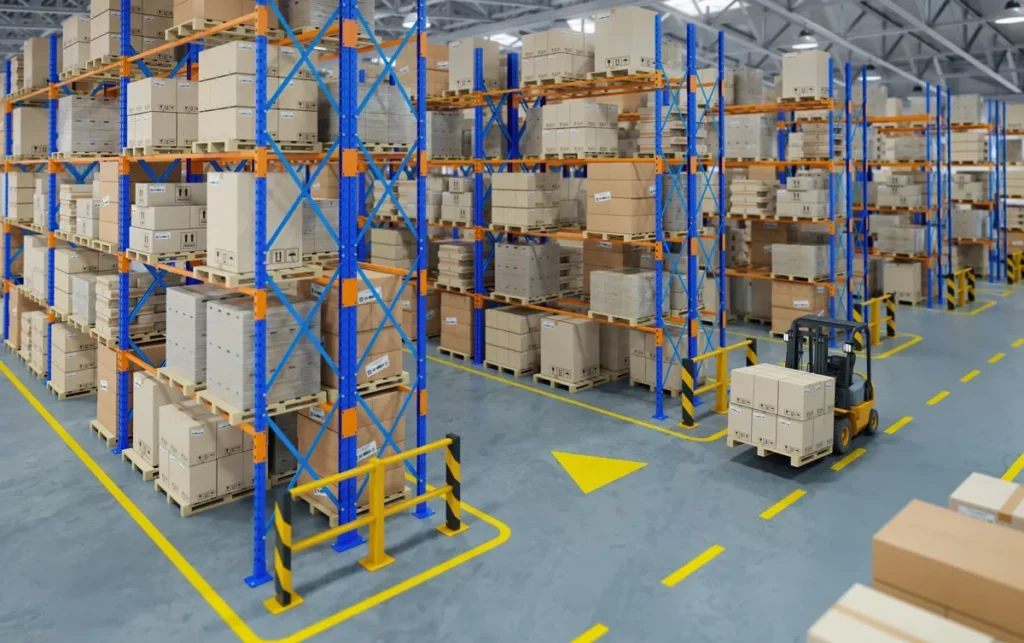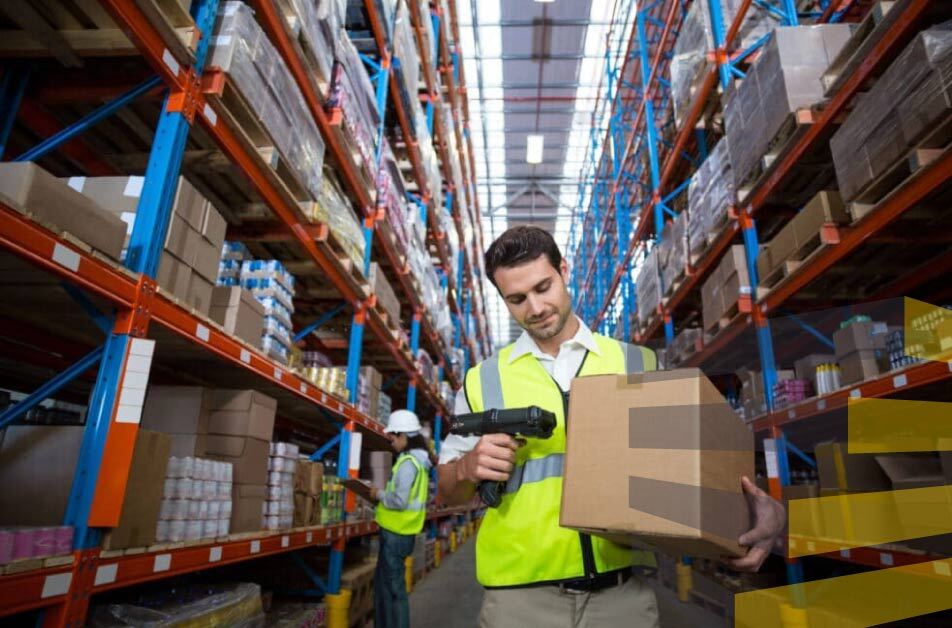Si deseas iniciar un negocio de almacenaje, abrir un centro de distribución o reubicar y renovar tu establecimiento, la instalación de estanterías de almacén es necesaria. Y para que este proceso sea rápido, seguro y no interrumpa tus operaciones, aquí tienes cinco consideraciones para que la colocación sea un éxito.
Las estanterías, así como la señalización, el etiquetado, la señalización del suelo y la instalación de barreras de protección, son una parte fundamental de la configuración de cualquier almacén y pertenecen a un sistema más complejo en el que la disposición y distribución adecuadas del espacio son indispensables.
Así, la instalación de estanterías de almacén es una serie de pasos ordenados y planificados que ayudan a colocar estanterías para almacenar mercancías y materiales. El tipo de estantería seleccionado dependerá del diseño de la distribución del almacén, de la estructura del edificio, de la variedad de mercancías y productos almacenados y del acceso a los mismos.
Además, la instalación de estanterías de almacén, sin poner en riesgo al personal, debe ser realizada por un consultor de instalación de almacenes. Estos expertos en normativa local se adaptarán a las necesidades y el presupuesto de su cliente sin comprometer la seguridad de los trabajadores.
Contáctanos si necesitas que un experto te ayude con la instalación de estanterías de almacén. Ofrecemos servicios en Brasil, México y Estados Unidos.
Instalación de estanterías de almacén: 5 aspectos a tener en cuenta
1. La seguridad siempre es lo primero
Minimizar cualquier riesgo dentro de una empresa de almacenaje o centro de distribución es vital para proteger a los trabajadores y no interrumpir las operaciones. Por este motivo, es necesario aplicar las normas de seguridad locales durante la instalación de estanterías de almacén y cualquier otro equipo.
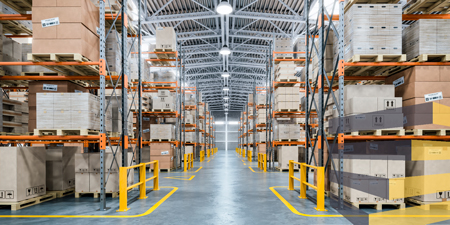
En Estados Unidos, la normativa para operar un almacén la establece la Administración de Seguridad y Salud en el Trabajo(OSHA); en Brasil, la Organización Brasileña de Normalización(ABNT); y en México, la Secretaría del Trabajo y Previsión Social(STPS).
Algunas normas son el uso correcto de los equipos de protección individual (EPI) y la formación constante del personal. Sin embargo, cuando se trata de la instalación de estanterías de almacén, debe prestarse especial atención a las capacidades de carga y a la altura máxima de las estanterías. Esto prolongará la vida útil de los equipos de almacenamiento y evitará que se desplomen y lesionen a alguien.
Además, durante la instalación de estanterías de almacén, debe tenerse en cuenta la calidad del equipo y los materiales con los que se ha construido. Y una vez instalados, deben inspeccionarse periódicamente para comprobar que están en buen estado y, si es necesario, mantenerlos o sustituirlos.
2. Materiales o mercancías almacenados
Para una instalación de estanterías de almacén satisfactoria y sin complicaciones, es necesario conocer el tipo de materiales y mercancías que se guardarán en el establecimiento. Esto le dirá cuántas estanterías se necesitan, de qué tipo y cómo se dispondrán dentro del inmueble para aprovechar al máximo el espacio.
Asimismo, los productos almacenados y la fase del proceso de producción determinarán el tipo de almacén y si se necesitan condiciones especiales de almacenamiento, como una cámara frigorífica. Puedes plantearte, por ejemplo, la necesidad de una zona techada o si esas mercancías pueden guardarse al aire libre.
En general, los productos que llegan a un almacén o centro de distribución se clasifican por tamaño, estado y peso. En su caso, también se tienen en cuenta el carácter perecedero y la fragilidad. Al mismo tiempo, los palés en las estanterías pueden ser irregulares, uniformes, de un solo uso y reutilizables.
La instalación de estanterías de almacén, especialmente cuando se trata de materias primas, debe tener en cuenta qué sistema se utilizará para manipular los productos. Por ejemplo, el sistema FIFO (primero en entrar, primero en salir) puede ser más apropiado para una operación de manipulación de productos perecederos que un sistema LIFO (último en entrar, primero en salir), ya que los artículos no pueden pasar mucho tiempo en las instalaciones.
3. Tipos de estanterías
Uno de los aspectos clave de la instalación de estanterías de almacén es el tipo de estantería que se va a instalar. Para hacer la mejor elección, hay que evaluar varios factores. Por ejemplo, la distribución del espacio, si el almacén es interior o exterior, o algunas condiciones especiales en función de la mercancía.
Normalmente, todas las estanterías utilizan un palé como base que soporta el almacenamiento de cajas y materiales pesados. A continuación, los palés se disponen en filas horizontales en varios niveles para aprovechar al máximo el espacio; el número de grupos, a su vez, depende del peso soportado por el material de base.
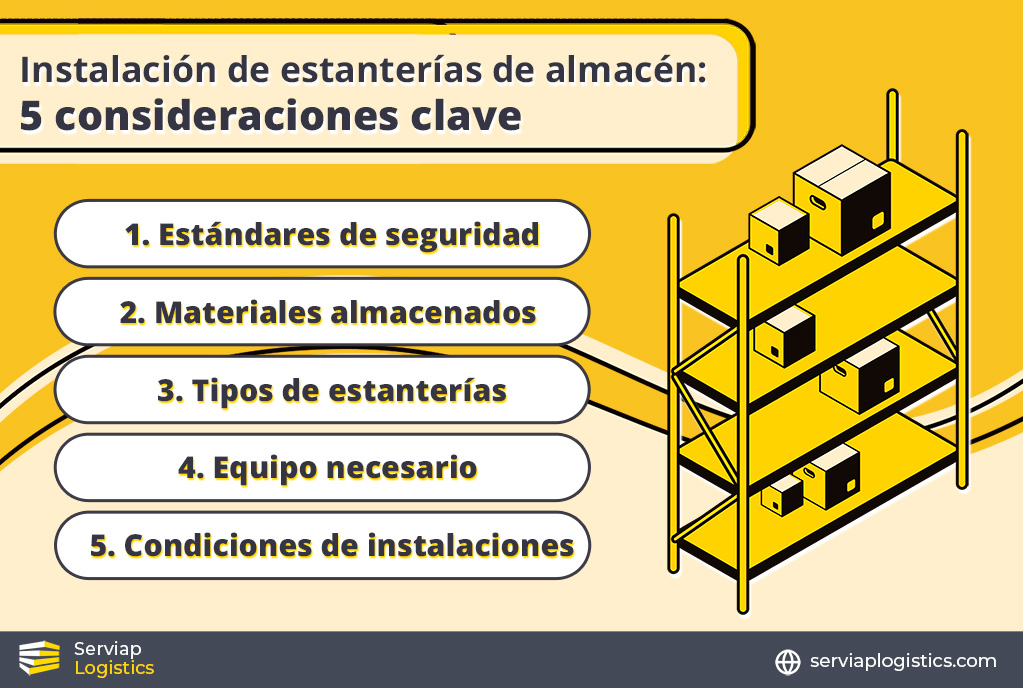
Las estanterías de paletización convencional son unas de las más populares y destacan por su capacidad para soportar mercancías pesadas en pequeños pasillos. Sin embargo, también hay disponibles estanterías de pasillo muy estrecho para aprovechar al máximo los espacios limitados.
También hay estanterías drive-in y drive-through, que permiten a los vehículos entrar y pasar a través de ellas; las estanterías de flujo de paletas utilizan un sistema FIFO; las estanterías push-back se basan en un sistema LIFO, mientras que las estanterías de doble profundidad ofrecen un término medio entre las disposiciones diseñadas para facilitar el acceso y las de almacenamiento de alta densidad.
4. Equipo necesario
La instalación de estanterías de almacén requiere equipos especiales, desde carretillas elevadoras para ayudar a levantar las estanterías hasta elevadores de tijera y herramientas de construcción en general, como taladros, martillos, destornilladores, llaves inglesas, etc.
En función de la normativa de cada territorio, habrá consideraciones específicas para los equipos que se utilicen. En Estados Unidos, por ejemplo, la norma MH16.1-2012 del American National Standards Institute (ANSI ) dicta que todas las columnas de las estanterías deben estar ancladas al suelo o, al menos, aseguradas con pernos.
Además, las columnas deben incluir una placa base y pernos de anclaje de calidad. Estos accesorios ayudarán a mantener las estanterías erguidas y firmes para soportar cualquier golpe de una carretilla elevadora o incluso un terremoto. El anclaje de las estanterías reducirá al mínimo los accidentes relacionados con el desplome de los estantes y la caída de los productos almacenados.
El suelo del almacén puede variar, ya que puede ser de linóleo y baldosas de composición vinílica, pero suele ser de hormigón. En este caso, habrá que utilizar herramientas especiales para facilitar la colocación de los equipos de almacenamiento, como cuñas de hormigón y anclajes de impacto.
5. 5. Condiciones de las instalaciones
A veces, las propiedades utilizadas para montar un negocio de almacenaje o un centro de distribución no están en las mejores condiciones. Desde problemas de humedad hasta suelos irregulares y grietas en el edificio, es necesario evaluar los requisitos del espacio antes de la instalación de estanterías de almacén.
El experto que contrate para la colocación de este equipo de almacenamiento debe asegurarse de que la losa será capaz de soportar las cargas que planea colocar sobre ella (libras por pulgada cuadrada), así como tener en cuenta los vehículos que transitarán por el lugar.
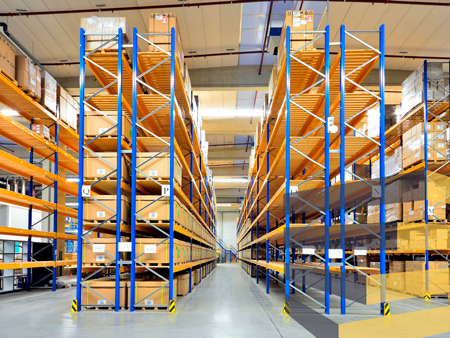
También es esencial tener en cuenta la altura a la que estarán las estanterías respecto al techo del edificio, ya que no deben chocar con los sistemas de seguridad contra incendios, como los aspersores, además de estar a una distancia considerable de las lámparas y la instalación eléctrica.
Los edificios más altos también pueden permitir una disposición más elevada de los equipos de almacenamiento durante la instalación de las estanterías de almacén. Sin embargo, es posible que las carretillas elevadoras no puedan llegar a las estanterías de los niveles superiores, lo que exigiría la compra de nuevas carretillas, un gasto que puede no haberse contemplado.
Serviap Logistics te ayuda con la instalación de estanterías de almacén
En Serviap Logistics ayudamos a nuestros clientes con la instalación de estanterías de almacén siguiendo las normas de seguridad en los negocios de almacenamiento y centros de distribución que aplican en sus territorios, ya sea en Estados Unidos, Brasil o México.
Además, ofrecemos servicios de etiquetado, señalización, marcaje de suelos, instalación de protección contra colisiones y montaje de equipos. Nuestra oferta también incluyen la gestión de proyectos, desde la planificación y supervisión de un nuevo almacén hasta su remodelación o traslado.
Gracias a la atención personalizada que ofrecemos y a la calidad de nuestros servicios, contamos entre nuestros clientes y socios satisfechos con algunas de las mayores empresas del mundo, de sectores como la automoción, el comercio electrónico y la venta al por mayor.
Contáctanos si estás a punto de abrir o trasladar un almacén y necesitas que un experto te ayude con la instalación de estanterías de almacén.


